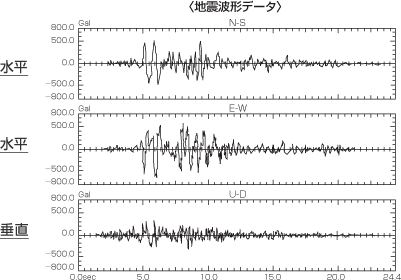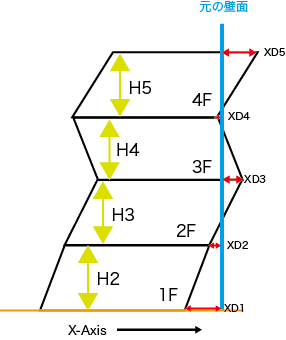Chapter1
Fundamental Knowledge About Earthquake
1.Unit to express the size of an earthquake
Vibration Frequency
Vibration frequency is the measurement of the number of cycles that occur per second. The main frequency component of earthquake is less than 10Hz and its vertical wave has higher frequency than horizontal wave.
Acceleration
Unit to express the acceleration of earthquake is *Gal. 980Gal=980cm/s2≒1G So called “Mega-earthquake” once occured in Japan; Hanshin, Chuetsu and Tohoku recorded the waveform of more than 1000Gal and it was clear that the acceleration was bigger than a gravitational acceleration (1G) generated in these quakes.980Gal=980cm/s2 ≒ 1G
Gal
Unit of acceleration, 1Gal=1cm/s2, and widely used in the field of seismology. “Gal” is categorized as non SI (international unit) with limitation. However, it is allowed to be used freely in gravitational acceleration or earthquake related matters.
Magnitude
Magnitude is the measure of an earthquake size from the focus. Generally, the deeper and larger the magnitude is, the more the vibration spreads.

- The deeper the epicentre, the wider the spread.
- Different epicentre depths have different surface intensities, even if the magnitude is the same.
Seismic Intensity Scale in Japan
At present, Japan Meteorological Agency use Shindo to measure the intensity of an earthquake. The Seismic Intensity Scale is calculated based on the ground acceleration waveform. The Seismic Intensity Scale may change after the calculation according to the earthquake duration and vibration.
See Chart
The value the JMA established was re-evaluated after the Great Hanshin/Awaji earthquake. It is classified into 10 scales; 0-4・5-lower・5-upper・6-lower・6 upper・7. Each country uses a different seismic scale .
| JMA Seismic Intensity |
Measured intensity | Human perception and reaction | Utilities and Infrastructure |
|---|---|---|---|
| 0 | Less than0.5 | Not felt by all or most people. | – |
| 1 | 0.5~1.5 | Felt by only some people indoors. | – |
| 2 | 1.5~2.5 | Felt by many people indoors. Some people awake. |
– |
| 3 | 2.5~3.5 | Felt by many people indoors. Some people are frightened. |
– |
| 4 | 3.5~4.5 | Many people are frightened. Some people try to escape from danger. | – |
| 5-lower | 4.5~5.0 | Most people try to escape from danger by running outside. Some people find it difficult to move. |
Gas meter with safety devices are tripped, stopping the supply of gas in same household.In rare cases, suspension of water supply may occur. |
| 5-upper | 5.0~5.5 | Many people are considerably frightened and find it diffucult to move | Gas supply pipelines to the household and major water pipes are damaged. |
| 6-lower | 5.5~6.0 | Difficult to keep standing. | Gas supply pipelines to the household and major water pipes are damaged. |
| 6-upper | 6.0~6.5 | Impossible to keep standing and impossible to move at all. | Gas pipeline to the local district and water distribution facility are damaged. |
| 7 | 6.5~ | Thrown by the shaking and impossible to move at will. | Water and electric supplies may stop over wide areas |
2.SI Value
SI Value
“Velocity response spectrum” is one of the standards to express an earthquakeʼs destructive power given on structures. If the structure has high rigidity, the velocity normal period is between 1.5-2.5 seconds. The integrated value (area of the spectral distribution) can be one of the factors to represent the destructive power of earthquakes. Therefore, it is called as “spectral strength : SI Value.”
SI Value is the standard to asses the earthquake
destructive
power on structures.
Why SI Value is necessary?
-
Even it is at the same acceleration or magnitude, damages on buildings may differ due to frequency range or time. The real damage on structures can not be estimated with the conventional seismic monitoring system based only on acceleration (Gal).
Therefore, value should be used to understand the real damage on structures. -

Compare with Nagaoka Municipal Waterworks Bureau and Ojiya Municipal Gas and Waterworks
Bureau.
When the Gas and Water Dept. in Ojiya City was struck by the earthquake, there
was no damage,despite the high acceleration.
In Nagaoka City where the acceleration was
low and SI Value was high, huge damage was observed.
“Summary of damages to gas supply business in Niigata Prefecture Chuetsu Earthquake reported by Gas Safety Subcommittee-May 2009”
Twelve gas suppliers recorded more than level 5 in seismic intensity
scale. After the earthquake, only Kashiwazaki Gas and Water Dept. had stopped supplying gas
due to severe damage of their establishment.
The SI and acceleration value are presented in this chart as monitored and recorded by the seismometer in each place.
Chart 1 Damage situation of each gas dept.
| Seismic Intensity |
Company | SI Value (Kine) |
Damage Situation (Gal) |
Damage Situation |
| 6 Upper |
Kashiwazaki Gas & Water Dept. |
99* | Kagami cho 999* Fujii 746 Kariwa1,000* |
About 34,000 houses of outage (Recovery target houses: 30, 978**) |
| 6 Lower |
Nagaoka Water Dept. (Mishima) | 50 | 293 | 120 houses for
trouble occurrence in supply (Recovery on 16th, July) |
| Ojiya Gas & Water Dept. | 23 | 323 | No damage | |
| Jyoetsu Gas & Water Dept. (Kashiwazaki) | 73 | 444 | 81 houses for trouble occurrence in supply (Recovery on 18th, July) |
|
| 5 Upper |
Hokuriku Gas Dept. (Nagaoka branch) | 46 | 527 | No damage |
| Kanbara Gas Dept. | 36 | 210 | No damage | |
| Nagaoka Water Dept. (Koshiji) | 38 | 258 | No damage | |
| Shirane Gas Dept. | 26 | 165 | No damage | |
| Sakae Gas Dept. | 24 | 174 | No damage | |
| 5 Lower |
Mitsuke Gas & Water and Sewage Facility | 34 | 254 | No damage |
| Kawaguchi Construction Dept. | 18 | 217 | No damage | |
| Uonuma Gas & Water Dept. | 9 | 145 | No damage |
(SI Value is the maximum level which each gas institution measured.)
*Measurement range excess
**Target house for recovery is the calculation amount after subtracting the sum of the number of houses
which donʼt use gas and the number of collapsed houses due to earthquake from the number of gas supply
houses.
3.Configuration
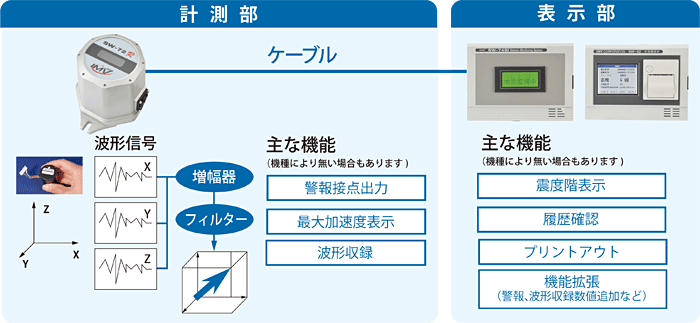
- A 3dimensional (XYZ) servo pickup and arithmetic circuit are built in the monitoring unit.
- The monitoring unit performs basic functions from digital processing to an alarm display.
- The functions can be extended beyond basic alarming by adding an external display.
4.Principle of Sensor
Sensors are generally classified into two categories; Electric and Mechanical types
All of IMV’s seismic monitoring systems adopt the electric type sensors.
Electric type
Servo type
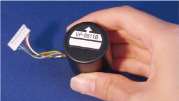
Typical principle of electrical systems. Stable output can be obtained from the
acceleration of a linear signal.
Seismographs incorporate this element in three axes.
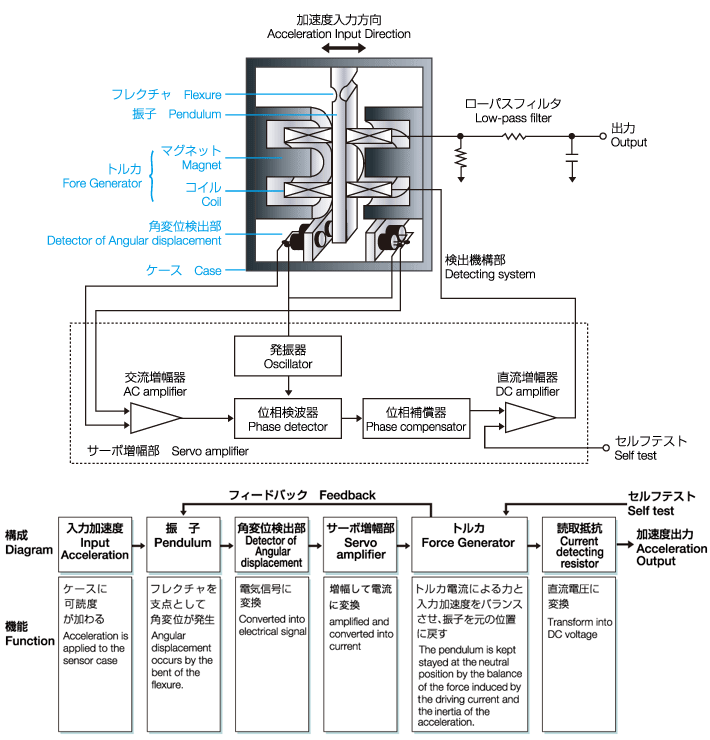
Mechanical type
-
Drop ball type
Reaction acceleration values are set by the dimensional ratio of the steel ball and the receiver.
Disadvantages: not yet compatible with direct earthquakes, maximum level not known.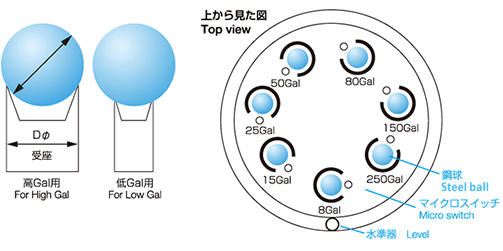
-
Pendulum type
Reaction acceleration values are set by the dimensional ratio between the contact and the micrometer.
Disadvantages: uncompliant with direct earthquakes, maximum level not known.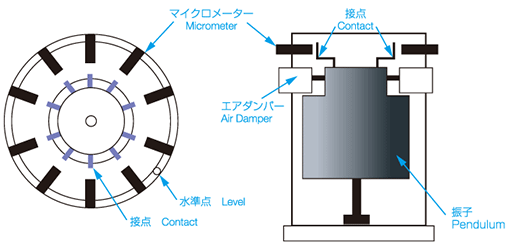
5.Damage Assessment
Damage assessment
It is difficult for anyone other than those with specialist knowledge to judge whether or not a structure damaged by an earthquake can continue to be used (entered). For this reason, efforts are being made to quantitatively determine this using the results of seismic observations, and the following parameters are being considered as evaluation criteria.
Interstitial deformation angle
It is derived from the ratio of the displacement of each storey caused by an earthquake to the
height of each storey.
When using seismic observation results, the amount of displacement is calculated based on the data detected by the sensors installed, and is then compared with the height of the building storey to determine the displacement.
Note that only displacements resulting from elastic deformation can be calculated from acceleration sensor values.When determining plastic deformation, injury needles, damper displacements, etc. are required. The magnitude of the inter-storey deformation angle is used as a design threshold in building codes.



